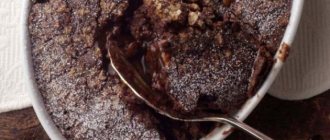Lactose intolerance, ethical veganism, health concerns, and simply a desire to try something new are the reasons why more and more people are replacing their usual cow's milk with plant-based drinks. Nowadays you can drink cappuccino with alternative milk in almost any coffee shop, but, unfortunately, it is not always tasty. I’ll tell you what to look for when choosing plant-based milk for coffee and how to make a delicious drink with it - at home or in a coffee shop.
Photo: https://europeancoffeetrip.com/almond-milk-for-baristas/
Soy
This is perhaps the most “classic” of plant-based alternatives. Soy milk can be found in almost every coffee shop and is quite common on supermarket shelves. Its taste is neutral, with a slight hint of legumes. The composition, depending on the manufacturer, may vary - for example, gellan gum is added as a stabilizer to milk created specifically for making cappuccino (for example, Alpro Professionals) so that it whips better and maintains its texture. And although a drink made with soy milk will not taste exactly the same as with cow’s milk, it is quite possible to achieve good foam and a balanced taste with “milk for professionals.”
However, soy milk has a significant drawback: it curdles with acidic coffee varieties. To prevent this, you can try adding slightly cooled coffee to cold milk and whisking it like raff. In addition, manufacturers do not recommend heating soy milk above 60 degrees, since at higher temperatures it can also curdle.
In addition to classic soy milk, there are also flavored options: banana, vanilla, chocolate. If you like to experiment with flavors, why not give it a try?
How many types of milk will be enough?
When it comes to plant-based alternatives, everyone has their own taste preferences. In addition, each type of milk has its own pros and cons. Therefore, it makes sense to have several options ready. “Today, coffee shop customers expect to see at least 2-3 plant-based options on the menu,” notes Andrea.
But you shouldn’t buy all the types of alternative milk that are available in stores. As with regular milk, it is important not to overdo it. Otherwise, the product will spoil before it can be sold. Keep track of how quickly ingredients are used up and replenish your stock in time.
Variant of milk coffee drink. ©Nathan Dumlao
On the issue of allergies
Don't forget that nut and soy allergies are some of the most common. Therefore, at Onyx Coffee Lab establishments, baristas cook with almond, coconut and oat milk. Allergies to these products are quite rare, and such milk goes well with coffee.
It is important that alternative milk drinks must be prepared separately from the rest. Such milk should not accidentally end up in regular drinks. Even traces of these products are enough to cause an allergic reaction.
“Make any drink as if an allergy sufferer ordered it,” advises Andrea. To avoid accidental contamination of allergens in coffee, her establishments have separate equipment for each type of milk. This, of course, will require additional costs and employee training, but it will allow you to keep up with the times.
The barista carries 2 drinks. ©Nathan Dumlao
Barista training
The more coffee preparation options you offer, the more work you will have to do on drink recipes and barista training. To maintain the proper quality of coffee and the reputation of the establishment, employees must be able to froth different types of milk and “draw” on the foam from them; know which alternatives go best with which type of coffee.
The most important thing to pay attention to is heating, as different foods react differently to high temperatures. A barista must know and be able to prepare such drinks at the proper level.
However, since coffee with almond or oat milk is ordered less often than regular coffee, employees will have fewer opportunities to learn everything they need to know on the job. Therefore, in order to be ready for any orders, you will have to devote more time and attention to training itself.
A barista steams milk. ©René Pollock
Coconut
Coconut milk refers to two completely different products, each of which can be found on store shelves:
— Coconut drink, usually based on rice (Bite) or soy (Alpro) milk. The coconut content in it is small, 3-5%, the texture is similar to low-fat cow's milk, and usually whips up well. However, preparing a balanced, delicious cappuccino will be more difficult than with soy cappuccino: the bright coconut flavor will pull the balance over itself. But a coconut latte will turn out pleasant and tender. As with soy, for this drink it is better to choose non-acidic coffees with a dense body so that the coffee flavor is not lost in the milk.
- Coconut milk - usually sold in cans (for example, Aroy-D). This is a product with high fat content, 17-19%. It is used in the preparation of soups, sauces, and desserts, but you can also make coffee drinks with it. For example, adding a small amount of coconut milk to soy or rice milk to achieve a creamier texture. Or serve with espresso or Americano instead of traditional cream. You can also make vegan raff with this milk - however, in this case it is better to dilute it with other milk to get about 10% fat content, otherwise it will be difficult to finish the drink.
Should coffee with Alternative milk cost more?
Many coffee shops overprice such drinks. But as their popularity grows, this is no longer necessary. Plant-based milk may be more expensive and sold less often, but by raising prices, you risk losing customers. Of course, this approach will bring short-term benefits. But a reasonable price will allow you to win a lot of regular visitors who will bring you more money in the long run.
As an option: you can reduce the cost of plant-based milk by buying it in bulk and with a long shelf life.
The barista prepares a latte. ©Andrew Tanglao
Alternative milk must be released
Clearly indicate on your menu what types of plant-based milks you offer. This information should immediately catch the eye: this will make a person more likely to order a more expensive drink based on alternative milk instead of a regular pour-over. In addition, if you offer a client’s favorite milk, then it is possible that he will come to you for the second and third time. The same applies to allergy sufferers, who sometimes find it difficult to find a suitable alternative.
Describe the taste, texture, or even environmental friendliness of a particular plant milk in the menu. Just like many coffee shops indicate the degree of roasting and the country of origin of the beans on the menu.
Plant milk is a unique ingredient that opens up endless fields for experimentation. According to Andrea, all of her establishments serve a special drink based on dairy-free alternatives, and it always becomes a bestseller. Customers perceive such a product as an independent drink, without thinking of it as an alternative to regular coffee.
Latte art. ©Frankie Photography
Take the time to explore plant-based alternatives. Let baristas practice working with different types of milk. Invite them to come up with their own drink recipe. This will allow you to expand not only the menu, but also significantly expand the circle of guests of your establishment!
Oatmeal
Oat milk has gained particular popularity in Russia: Nemoloko brand drinks are sold in any supermarket and are significantly cheaper than any other plant-based milk. At the same time, in terms of composition and taste, it is not inferior to more expensive analogues, and in terms of fat content (if you choose a pack that says “3.2%”) it is the same as cow’s milk, which is usually used in coffee shops. In addition, oat milk does not require added sugar: during its production, part of the complex carbohydrates of oats is broken down into glucose, and this gives the milk a pleasant sweetish tint. Baristas note that oat milk froths well, the foam is quite suitable for latte art, and due to its neutral taste, oat milk goes well with different types of coffee.
An absolute favorite among plant-based milks for coffee is the Swedish brand Oatly. This oat milk is used all over the world, and it truly is the closest thing to cow's milk in a cappuccino: smooth, sweet, and the perfect texture for latte art. The manufacturer's website has a tip for non-baristas: “Simply heat the drink in a container, swirling until it starts to foam, and then make yourself a “dairy-free latte.” Well, you can try it!
Beneficial properties of plant-based dairy products
The refusal of natural dairy products is due not only to the fashion for vegetarianism, but also to the peculiarities of digestion. Some people are lactose intolerant; the plant version does not contain this substance. At the same time, oat milk contains gluten, which means it is contraindicated if there is a lack of enzymes that break it down.
Is it possible to drink coffee with oat milk - you can, but it is not advisable to exceed its quantity: the norm per day is no more than 2 glasses. Oatmeal is good for people practicing a protein diet. It contains the necessary amount of natural carbohydrates, sufficient for proper brain function.
For example, the famous French nutritionist Pierre Dukan recommends consuming 2 tablespoons of oat bran daily so as not to feel hungry while eating vegetables and meat. This is facilitated by the natural sugar contained in oatmeal. Calorie content – 17 units without sugar.
Coffee is not prohibited in weight loss diets; it is even recommended for maintaining physical and mental energy. Green grains, which can also be brewed with milk, are especially useful.
Almonds are useful for maintaining physical activity, as well as for people who are prone to high blood pressure. Nuts contain a lot of calcium - this is the advantage of almonds over soy.
What is coffee with cream called?
Coffee with cream does not have one name that everyone understands. More precisely, there are some regional ones, for specific recipes that are found in different countries:
- Palazzo is a Californian recipe. Two servings of chilled espresso are poured with a sweetened creamy milk mixture.
- Espresso con Panna - an analogue of cappuccino, an Italian recipe - espresso with whipped creamy foam, sprinkled with cinnamon.
- Irish - coffee with alcohol and a creamy head (Irish whiskey is usually used, although brandy or cognac is acceptable).
Viennese coffee is the most popular name in the post-Soviet space, although in Vienna itself it is more often prepared with foamed milk.
Our body does not digest milk
Secondly, if your significant other excitedly starts talking about how “cow’s milk is not absorbed in the body,” do not believe her. This is the same blatant and blatant lie that bloggers, tabloids and not the most competent media have imposed on the masses. The wording that milk is not absorbed in the body is fashionable, but subjective and the results of studies vary greatly to make a 100% conclusion.
Well, personally, it’s very difficult for me to deny the fact that for many centuries in a row our ancestors believed that milk “from under the cow” meant health, they happily gobbled up rich village cottage cheese, sour cream and cream on both cheeks, and had good health and excellent physique. Of course, it is possible that the whole point is a combination of factors and the fact that then “the trees were greener and the water was cleaner.”
Photo: istockphoto.com
Not for fashion's sake
In general, to summarize, I don’t see many reasonable reasons for switching to plant-based milk. The main thing is that this transition does not occur because it is “fashionable.” Don't be fooled by what the crowd thinks and listen to how your body feels. No one can tell you better than him.
Perhaps you really feel as comfortable as possible about giving up meat or milk. But to refuse does not mean manically looking towards glazed cheesecakes or steak in anticipation of a breakdown that will definitely happen, but to completely calmly and consciously decide not to eat this or that product. This is why I have so much respect for those who completely calmly do not eat what they don’t want and call themselves whatever they want: vegan, vegetarian, fruitarian or raw foodist. And I absolutely don’t understand those who can’t wrap their heads around why they need this soy latte, they drink it, they’re sad, but they continue to drink it.
In general, I am for reasonable consumption, which is what I wish for you. Don’t make a cult out of food, but enjoy it and get the necessary source of energy from it!
Cutlets “Like meat”
Of course, an experienced meat-eater will suspect something is wrong, but due to the successful selection of spices, it will be difficult to guess that these are just flakes, especially quick-cooking ones .
- Oat kvass: beneficial properties, recipes, contraindications
You will need:
- 400 g instant oat flakes
- 250 ml water
- 5 eggs
- 2 onions
- 1 head of garlic
- cumin, turmeric, salt, pepper to taste
Boil water and steam the flakes in it for 5 minutes. During this time, peel the garlic and onion and chop them finely (it is better to pass the garlic through a garlic press ). Then fry the vegetables in vegetable oil and mix them with flakes and spices . Add the eggs and mix everything thoroughly until the mixture is smooth . Fry the cutlets for 5-7 minutes on each side, first rolling them in flour.










